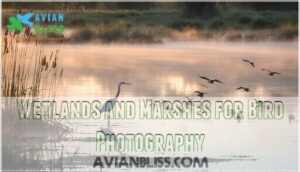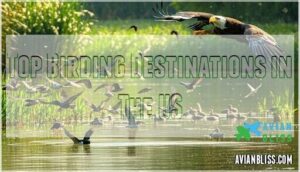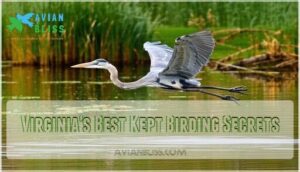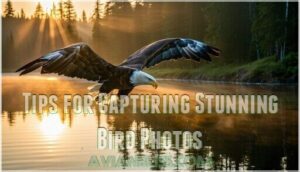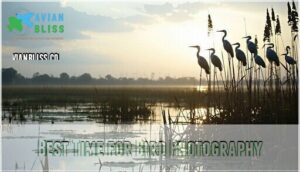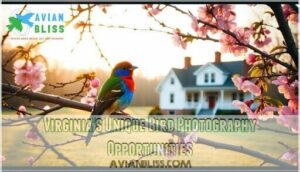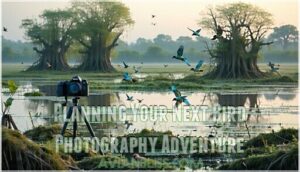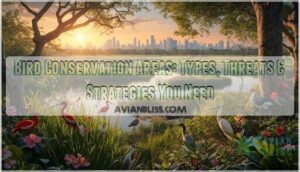This site is supported by our readers. We may earn a commission, at no cost to you, if you purchase through links.
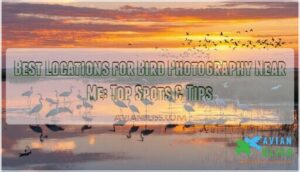
Wetlands and marshes attract waterfowl and wading birds, while forests are perfect for colorful songbirds like warblers.
Coastal areas often feature dramatic flocks of shorebirds and pelicans—great for action shots!
Check migration hotspots; they’re like nature’s red carpet for rare species.
Local parks, wildlife refuges, or even your backyard can surprise you with feathered visitors.
Use early mornings for golden light and active birds.
With a little patience and research, you’ll capture stunning moments that make even pigeons look like celebrities.
Keep your camera ready!
Table Of Contents
- Key Takeaways
- Best Bird Photography Spots
- Best Locations for Bird Photography Near Me
- Popular Bird Species to Photograph
- Top Birding Destinations in The US
- Virginia’s Best Kept Birding Secrets
- Tips for Capturing Stunning Bird Photos
- Best Time for Bird Photography
- Virginia’s Unique Bird Photography Opportunities
- Planning Your Next Bird Photography Adventure
- Frequently Asked Questions (FAQs)
- What’s your favorite location for wildlife photography?
- Where is the best place to photograph wading birds?
- Where are the best bird photo hotspots?
- Where is the best place to bird watch in Washington DC?
- Where can I photograph birds in breeding plumage?
- Should I use eBird for bird photography?
- Where are the birding spots in Chicago?
- Where to see birds in Illinois?
- Where can I find birds to photograph?
- What is the best setting for bird photography?
- Conclusion
Key Takeaways
- Explore nearby wetlands, forests, and coastal areas to find diverse bird species and stunning photo opportunities.
- Use apps like eBird or join local birding clubs to discover hidden hotspots and track recent sightings.
- Plan outings during early mornings or migration seasons for ideal lighting and active birds.
- Respect wildlife and habitats by keeping a safe distance and practicing ethical bird photography.
Best Bird Photography Spots
You don’t have to travel far to find incredible bird photography spots that blend natural beauty with diverse species.
Incredible bird photography awaits nearby, merging stunning natural beauty with the charm of diverse avian species in their element.
From coastal shores to mountain trails and quiet wetlands, each location offers unique chances to capture stunning shots of birds in their element.
Coastal Birding Hotspots
Explore Virginia’s coastal bird photography hotspots for unforgettable shots.
The Eastern Shore of Virginia National Wildlife Refuge and Back Bay National Wildlife Refuge buzz with seabird colonies and shorebird migrations.
Spot Bald Eagles or beach-nesting Oystercatchers while soaking in stunning ocean views.
- Embrace coastal migrations and their seasonal beauty.
- Feel awe capturing delicate estuary birding scenes.
- Master patience with coastal birdwatching—a rewarding skill!
Mountain Birding Destinations
For stunning mountain bird photography, Virginia’s Appalachian Mountains are a goldmine of diverse species and breathtaking scenery.
Explore Shenandoah National Park for its panoramic views and vibrant forest birds or venture to Mount Rogers to glimpse highland habitats and rare avians. Early mornings, when mountain migration peaks, provide the best light and activity.
- Scout Blue Ridge birding locations to find raptors roosting or feeding.
- Hike trails quietly for natural bird behavior amidst Appalachian species.
- Use long lenses to capture forest birds without intrusion.
- Shoot during golden hours for the best contrast and color.
Wetlands and Marshes for Bird Photography
For bird lovers looking for "bird photography near me," Virginia’s wetlands and marshes are a treasure trove of avian diversity.
Brimming with life, these brackish ecosystems are perfect for capturing unique bird species.
Master tidal photography skills by observing wetland habitats and migration schedules.
A telephoto lens is essential for wildlife photography locations like marshes, letting you get close without disturbing your feathery subjects.
Bring patience—birds don’t pose on command—and don’t forget ethical practices.
Great marsh shots depend on timing, sharp focus, and thoughtful composition.
Best Locations for Bird Photography Near Me
How do you find the best bird photography locations near you? Start by exploring local birding spots through birding apps like eBird or Merlin. These tools pinpoint nearby hotspots and even show recent bird sightings.
Community science projects often update these apps, making them your go-to for accurate data. Join local birding clubs to unearth hidden gems—marshes, small wetlands, or wooded trails—that escape public radar.
These insiders know where to find rare birds, helping you get those bucket-list shots. Remember, photography ethics are key. Use zoom lenses to keep a safe distance, especially near nesting sites.
Conservation efforts thrive when we respect wildlife habitats. Here’s a quick guide to finding top bird photography spots:
- Use birding apps to locate active areas.
- Check local parks and nature reserves.
- Join birding meet-ups for insights.
- Explore areas with fresh water or food sources.
- Visit during early mornings for the best light!
Popular Bird Species to Photograph
Virginia is home to stunning bird species that will elevate your photography, from majestic bald eagles to colorful warblers.
You’ll love capturing their beauty in action, whether they’re soaring, singing, or wading through serene wetlands.
Bald Eagles in Virginia
Virginia offers some of the best bird photography locations, especially for capturing the iconic Bald Eagles. These majestic birds thrive thanks to conservation efforts and can be spotted soaring above scenic waters like the Potomac River.
Breathtaking Bald Eagles soar majestically above Virginia’s scenic waters, offering unforgettable moments for bird photography enthusiasts and nature lovers alike.
Head to Mason Neck State Park, a prime eagle nesting site, where you might see eagles in flight or perched regally in trees. Virginia’s Chesapeake Eagles are a treasure for photographers, showcasing their powerful wingspans and sharp gazes.
While photographing, respect eagle rehabilitation efforts by keeping your distance and preserving their natural habitat. Whether during eagle migration or year-round, Bald Eagles in Virginia promise incredible snapshots and unforgettable moments in some of the state’s best birding locations.
Osprey and Other Birds of Prey
Osprey are a treat for bird photographers, with their dramatic dives and remarkable wingspans.
These raptors, often spotted near water, captivate audiences as they snatch fish mid-flight.
Nesting near coastlines and lakes, they’re perfect subjects for action shots.
To honor their conservation status, explore bird sanctuaries near you and practice responsible bird photography.
Keep your distance—no one likes a nosy neighbor, especially these skilled hunters guarding their nests.
Their hunting techniques are pure avian magic, showcasing their unique abilities as they hunt with precision and skill, making them a delight to observe and photograph, while also emphasizing the importance of respecting their personal space.
Warblers and Songbirds
Catching a glimpse of songbirds like Golden-winged or Cerulean Warblers feels like striking gold.
Visit Mount Rogers Recreation Area or Shenandoah National Park during spring migration to find these beauties in their natural songbird habitats.
Listen closely for unique vocalizations—it’s like nature’s very own symphony. Remember, patience is key for warbler identification, but the payoff for bird photography tips is stunning.
Waterfowl and Wading Birds
When you’re exploring wetlands for bird photography, waterfowl and wading birds offer endless inspiration.
Here are four must-visit spots:
- Back Bay National Wildlife Refuge: Spot snow geese or tundra swans in winter.
- Great Marsh Trail: Capture heron behavior in peaceful habitats.
- Mason Neck State Park: Perfect for black-crowned night-herons.
- Wetland Conservation Areas: Highlight shorebird migration and wading bird diets.
Top Birding Destinations in The US
If you’re looking for legendary birding spots across the U.S., you’ll find no shortage of incredible destinations packed with wildlife.
From the urban oases of New York City to the biodiversity-rich landscapes of Texas, each location offers unique opportunities to capture stunning shots.
Harlingen, Texas for Bird Diversity
Harlingen, Texas, is a birder’s dream, especially during the Rio Grande Valley Birding Festival each fall.
With over 500 species, it’s overflowing with birding gems like the vibrant Green Jay and Altamira Oriole.
Harlingen hotspots abound with tropical birding opportunities, including Texas specialties like the Red-crowned Parrot and Great Kiskadee.
These migratory bird locations buzz with activity, offering endless chances for avian photography.
Bring your longest lens—the Valley birds love their personal space.
For the best bird watching locations, team up with local guides who know these stunning avian photography sites inside out!
New York City for Urban Birding
New York City might be bustling, but it’s also a goldmine for bird photography, blending nature with its urban charm.
Central Park draws migrating species, offering a chance to spot vibrant warblers or hear a wood thrush’s haunting melody. Bryant Park surprises birders with its lunchtime visitors, while Staten Island feels almost wild with its green havens.
- Look up for red-tailed hawks gliding near skyscrapers.
- Discover secret urban birding locations with friendly local enthusiasts.
- Explore urban habitats rich with NYC bird species.
- Respect photography ethics while capturing these avian wonders, and remember to appreciate the urban charm.
Toledo, Ohio for Warbler Migration
Each May, Toledo buzzes with activity as warblers flood the region during spring migration.
The Biggest Week in American Birding Festival draws enthusiasts to places like Magee Marsh and Ottawa NWR.
These pristine birding spots on Lake Erie offer vibrant backdrops for bird photography.
Here’s a snapshot of what awaits:
| Location | Highlights | Best for |
|---|---|---|
| Magee Marsh | Warbler ID, trails | Spring migration |
| Ottawa NWR | Scenic wetlands | Bird species photography |
| Lake Erie | Colorful flocks | Migratory birds |
Point Reyes National Seashore, California
Point Reyes National Seashore offers some of the best nature photography spots along the Pacific Flyway, with nearly 500 bird species, jaw-dropping vistas, and wildlife diversity.
From gray whales breaching at Drakes Bay to Tule elk roaming meadows, this spot is a dream for photographers. You’ll also find coastal raptors soaring over dramatic cliffs.
- Don’t miss the iconic Cypress Tunnel, perfect for morning light shots.
- Hit the birding trails near me, where marbled murrelets nest in quiet corners.
Coastal fog adds an ethereal touch, transforming ordinary pictures into art.
This unforgettable mix of bird sanctuaries and breathtaking landscapes is a must-see!
Virginia’s Best Kept Birding Secrets
You’ll find some of Virginia’s best bird photography spots where nature feels untouched and the views are breathtaking.
From the serene wetlands of Back Bay to the rugged peaks of Grayson Highlands, each location offers unique opportunities to capture Virginia’s incredible birdlife.
Shenandoah National Park
Shenandoah National Park offers a bird photography haven with Skyline Drive’s overlooks, Hawksbill Summit’s views, and serene waterfall hikes.
Spot Cerulean Warblers, Bald Eagles, and witness bird migration in action.
Dense forests, open meadows, and trails like the Appalachian offer Black Bear sightings and countless birding opportunities. Bring your gear early; mornings maximize light and bird activity, ensuring stunning nature photography in one of Virginia’s most iconic national parks.
Back Bay National Wildlife Refuge
Back Bay National Wildlife Refuge near Virginia Beach is a treasure for bird enthusiasts and shutterbugs alike.
Its diverse habitats include maritime forests, freshwater marshes, and sandy beaches.
During seasonal migrations, you’ll see:
- Snow geese and tundra swans creating stunning landscapes.
- Bald eagles soaring gracefully above.
- Migratory birds like egrets and herons in the marshes.
- Waterfowl gliding across serene waters.
Don’t forget to check out wildlife photography permits to preserve this refuge’s beauty for generations.
Eastern Shore of Virginia
The Eastern Shore of Virginia, with its Barrier Islands and serene Coastal Habitats, is a haven for bird photography.
Explore Chincoteague and Assateague, where wild ponies roam alongside Migratory Birds.
Capture osprey hunting near quaint fishing villages or brown pelicans soaring along the Atlantic Coast.
The Eastern Shore National Wildlife Refuge offers perfect Seaside Photography spots, especially during migration, where each frame reflects the timeless rhythm of nature’s beauty.
Grayson Highlands State Park
At Grayson Highlands State Park, you’ll encounter a nature-lover’s dream with wild ponies grazing against breathtaking highland scenery.
The Virginia Bird and Wildlife Trail (VBWT) adds to the charm, offering unique mountain birdwatching opportunities.
- Capture Golden-winged Warblers nesting in lush meadows.
- Spot Red-breasted Nuthatches in spruce-fir forests.
- Snap dramatic shots of soaring ravens along rocky trails.
- Witness Chestnut-sided Warblers fluttering near rhododendron blooms.
- Listen for Northern Saw-whet Owls in dense woodlands.
Tips for Capturing Stunning Bird Photos
Capturing stunning bird photos takes patience, the right gear, and a good understanding of your subject.
Focus on timing, lighting, and learning bird behavior to turn ordinary shots into extraordinary moments.
Camera Equipment and Settings
Bird photography takes patience, practice, and precise camera settings.
For stunning shots, focus on customizing your Shutter Speed, Aperture Priority, and ISO Settings to the scene.
Here’s a quick reference:
| Setting | Still Birds | Flying Birds | Low Light |
|---|---|---|---|
| Lens Type | 300mm Prime | 70-200mm Zoom | Wide-aperture |
| Shutter Speed | 1/500 sec | 1/2000 sec | 1/250 sec |
| Aperture | f/8 | f/5.6 | f/4 |
| ISO | 400 | 800 | 1600-3200 |
| Tripod Use | Optional | No | Highly recommended |
A fast shutter speed freezes motion, while lower apertures blur backgrounds.
Selecting the right lens enhances clarity.
Experiment outdoors!
Lighting and Composition
Great lighting can make your bird photos unforgettable, and there’s no better time than the Golden Hour—the soft, warm sunlight enhances feather textures and creates stunning background blur. Think of it as nature’s perfect Instagram filter!
When composing shots, focus on simplicity. The rule of thirds helps you create balanced, eye-catching images. Imagine gridlines dividing your frame and place your bird at one of the intersections.
Leading lines, like tree branches or water ripples, naturally guide the viewer’s eye to your subject. Keep backgrounds clean—no one wants a telephone pole ruining an otherwise gorgeous shot. Ideal results may require specialized lighting equipment.
- Golden Hour magic: Soften shadows and enrich details.
- Rule of thirds: Position wisely.
- Leading lines: Direct attention naturally.
- Simplify for impact: Less is more.
Bird Behavior and Habitat
If you want incredible bird photography, learning bird behavior is a game-changer.
Birds have distinct daily routines, and understanding their nesting habits, feeding strategies, and social behavior reveals timing and patience.
| Behavior | Best Time | Photo Tips |
|---|---|---|
| Feeding | Dawn/Dusk | Stay low, move like a ninja |
| Nesting | Spring | Use a long lens, keep afar |
| Singing | Early morning | Zoom in, find open perches |
| Bathing | Midday | Position near water |
| Flying | Anytime | Snap fast, freeze motion |
A closer examination of avian behavioral patterns can further enhance your understanding.
Respect bird habitats while snapping shots. It’s their home, after all!
Post-Processing and Editing
Capturing the perfect bird photo is only half the fun—editing brings it to life.
Start with RAW Conversion to preserve details.
Then, try these quick fixes:
- Use Sharpening Techniques for crisp feather details.
- Enhance colors with Color Correction for lifelike vibrancy.
- Simplify your shot using Cropping Composition.
- Apply Noise Reduction for clear early-morning birdwatching images.
These photography tips elevate your shots effortlessly!
Best Time for Bird Photography
The best time for bird photography depends on understanding migration seasons, breeding cycles, and light conditions.
Early mornings and late afternoons offer soft light and active birds, making these hours your perfect window for stunning shots.
Migration Patterns and Seasons
Timing is everything with bird migration!
Spring (March-May) and fall (August-November) bring colorful migratory species along the Atlantic Flyway.
Seasonal changes guide avian species to Virginia’s hotspots like Back Bay Refuge, where snow geese dazzle.
Shenandoah’s ridges see hawks soaring thermals every October.
Keep an eye on weather impacts—clear mornings often mean more birds en route for stunning seasonal photography opportunities, especially for seasonal photography.
Breeding and Nesting Seasons
Breeding and nesting seasons are a goldmine for bird photography enthusiasts. Spring and summer bring nesting behaviors, colorful courtship, and busy parents raising hatchlings.
Here’s what to look for:
- March-April: Courtship dances, intricate nests, chosen habitats.
- May-June: Eggs laid, incubation periods underway.
- June-July: Fledgling care, wobbly first flights.
Respect protects: snapping close-ups disturbs delicate habitats. Visit Virginia’s bird sanctuaries or check “bird sanctuaries near me” for a memorable birding experience!
Optimal Lighting Conditions
Good lighting can transform bird photography from ordinary to breathtaking.
The Golden Hour steals the show, bathing birds in soft, warm tones perfect for outdoor photography. Cloudy days? They’re a hidden blessing—no harsh shadows, just even light.
Play with backlighting birds during sunrise or sunset for striking silhouettes. Got a reflector? Use it to bounce light onto shaded spots.
Here’s a quick guide:
Experiment with light to uncover your best photo opportunities!
Weather and Climate Considerations
Don’t let Virginia’s fickle climate throw you off your bird photography game.
Early morning spring days, with soft winds under 10mph, promise gorgeous lighting. Cloudy skies aren’t a downer—they’re your secret weapon for balanced, shadow-free portraits.
Summer’s midday blaze? Not so much. And light rain? Great for action shots, but pack weather gear!
Climate change shifts bird behavior, so stay observant. Seasonal impacts keep Virginia birdwatching wonderfully unpredictable.
Virginia’s Unique Bird Photography Opportunities
Virginia offers an incredible variety of bird photography opportunities, from coastal marshes teeming with wading birds to mountain trails buzzing with warblers.
You’ll find breathtaking landscapes, fascinating wildlife, and even a touch of history to frame your perfect shot.
Coastal Landscapes and Seascapes
Virginia’s coastal region is a treasure trove for bird photography.
Start your day capturing stunning ocean sunrises at Chincoteague’s unspoiled beaches or explore the Chincoteague National Wildlife Refuge for shoreline wildlife in action.
Back Bay National Wildlife Refuge showcases osprey diving theatrics, while Virginia Beach serves up visually dynamic seascape compositions.
Don’t miss Norfolk Botanical Gardens for intimate beach photography moments, blending artistry with the calming effects of the coast’s natural beauty, in a setting that offers unique opportunities for wildlife photography.
Mountain Scenery and Wildlife
Leave the coast behind and venture into Virginia’s Appalachian ecosystems for breathtaking mountain views and wildlife.
Shenandoah National Park’s scenic overlooks are perfect for forest bird photography, where you can spot Peregrine Falcons soaring.
Focus your lens on Mount Rogers’ highland ponies grazing near Red-winged Blackbirds, or capture the beauty of the Blue Ridge Mountains with their cascading waterfalls and roaming Red-tailed Hawks.
Every trail feels like nature’s gallery—don’t miss it, and for Black bear photography enthusiasts, pack patience to make the most of this natural wonder.
Historical Sites and Architectural Landmarks
Pairing bird photography with Virginia’s historical sites adds depth to your work, blending nature and history seamlessly.
Imagine capturing hawks soaring over Hollywood Cemetery’s colonial architecture, or snapping songbirds in Monticello’s historic gardens.
For breathtaking plantation photography, try shooting eagles above Fredericksburg’s Civil War sites or falcons flying over preserved landmarks.
- Hollywood Cemetery: Dramatic backdrops of historic monuments.
- Monticello: Birds nestled in Jefferson’s gardens.
- Fredericksburg: Wide spaces for catching soaring raptors.
Planning Your Next Bird Photography Adventure
Planning your next bird photography outing starts with knowing where to go and what to expect from the local wildlife.
With the right preparation and a little patience, you’ll be ready to capture stunning shots while respecting nature’s schedule.
Researching Locations and Species
How do you find the best birdwatching locations? Start with Species Identification apps or connect with Local Experts who know Virginia’s hidden gems.
Explore Habitat Research to understand where bird species thrive. Track Migration Patterns using eBird, and check each species’ Conservation Status for insight.
Timing’s everything—plan around sunrise for magical lighting. A little prep makes bird photography not just rewarding but an adventure worth every moment!
Preparing Equipment and Gear
Start your birding adventure prepared and stress-free.
Use a telephoto lens (400mm+), a sturdy tripod for stability, and an all-weather gear backpack.
Protect your camera with lens cleaning supplies and weather protection—rain or shine, birds keep moving.
Carry extra memory cards, spare batteries, and consider a flash diffuser for dim settings.
Great bird photography relies on precision: proper setup and care guarantee you capture Virginia’s breathtaking birdwatching moments without missing a shot.
Safety and Etiquette Considerations
Respect the habitat, avoid disturbing birds, and stick to trails.
Gear security is key, so pack carefully and prepare for unpredictable weather. Never lure or bait—ethical birdwatching values conservation over convenience.
Move quietly, watch for signs of bird stress, and remember: a relaxed subject makes for better bird photography.
Check for legal permits too—nature’s laws and local rules go hand in hand. Respect wildlife, and nature will reward you!
Frequently Asked Questions (FAQs)
What’s your favorite location for wildlife photography?
Imagine this: you’re wandering through Grayson Highlands State Park, camera in hand, spotting wild ponies against a backdrop of stunning Appalachian vistas.
The mix of trails and wildlife makes it a photographer’s dreamscape.
Where is the best place to photograph wading birds?
Head to wetlands or estuaries like Great Falls Park or Back Bay National Wildlife Refuge.
You’ll spot wading birds like herons and egrets striking elegant poses, perfect for capturing their graceful antics and serene reflections.
Where are the best bird photo hotspots?
Virginia’s bird hotspots include Back Bay National Wildlife Refuge for coastal birds, Great Falls National Park for waterbirds, and Shenandoah National Park for mountain species.
Bring patience, a zoom lens, and maybe bug spray—you’ll thank me!
Where is the best place to bird watch in Washington DC?
The National Arboretum is perfect for birdwatching in Washington, DC.
You’ll spot migratory birds, owls, and woodpeckers among blooming gardens and serene trails.
It’s a peaceful escape, right amidst the city.
Where can I photograph birds in breeding plumage?
Like nature’s fashion show, spring and early summer are perfect for capturing birds in breeding plumage.
Visit wetlands, coastal refuges, or forest edges, where vibrant warblers, herons, and waterfowl display their most stunning colors.
Should I use eBird for bird photography?
eBird helps you track birding hotspots, find species in breeding plumage, and plan your trips efficiently.
It’s like having a birding buddy who always knows where the action is—super handy!
Where are the birding spots in Chicago?
Chicago has fantastic birding spots like Montrose Point Bird Sanctuary, known for migratory birds, Jackson Park’s Wooded Island, and the Skokie Lagoons.
Each offers unique habitats, perfect lighting, and diverse species for incredible photography opportunities!
Where to see birds in Illinois?
Imagine spotting a bald eagle soaring over Lake Shelbyville or listening to warblers in Shawnee National Forest.
Illinois offers rich birding spots—visit Emiquon Preserve or Nachusa Grasslands for diverse habitats and stunning feathered friends.
Where can I find birds to photograph?
Grab your camera and visit local parks, wildlife refuges, or nature trails.
Look for spots with water—birds love wetlands!
Early mornings offer soft light and active birds, making photography magical.
Patience is key!
What is the best setting for bird photography?
The best setting for bird photography combines early morning light, a fast shutter speed, and a long lens.
Use burst mode for action shots.
Patience matters—sometimes the perfect shot takes waiting longer than the bird itself!
Conclusion
Sometimes, the best locations for bird photography near you’re closer than you’d think—just a park visit or backyard observation away.
By exploring diverse habitats like wetlands, forests, or coastal trails, and timing your outings with migration seasons or early morning light, you’ll capture extraordinary bird moments.
Don’t forget, understanding bird behavior and equipping yourself with solid gear makes all the difference.
So grab your camera, stay curious, and turn those fleeting winged wonders into frame-worthy memories!



